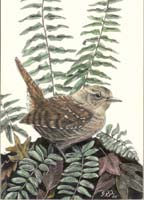 |
||||||||||||||||||||||||||||||||||
|
||||||||||||||||||||||||||||||||||
|
Snow Birds Stay With Us Year RoundLook in the winter leaves for the most intrepid of wrensAbout the time of the first cold days of late autumn, the snowbirds arrived in lowland areas of the mid-Atlantic. A few months earlier, September brought a wave of other small songbirds — warblers, thrushes, vireos — through the area. Most are gone now, moved on to southern locales. Other types of birds such as hawks, gulls and shore birds have also passed us by. The name snowbird is often reserved for the common dark-eyed junco, a slate-gray bird familiar in back yards and along roadsides. But I use it in a more general way to refer to a cohort of various small birds that spend their summers in cooler parts of the continent and pass the winter in the relatively temperate mid-Atlantic. Other snowbirds are the white-throated sparrow, golden-crowned and ruby-crowned kinglets and the winter wren.
True to its name, the tiny winter wren ventures farther north than any of its kin. This snowbird is one of 59 species of wrens occupying varied habitats throughout North and South America, from rainforests to deserts, marshlands, woods and canyons. The case can be made for winter wrens as the most intrepid of all wrens. Two million years ago, give or take a few months, winter wrens seem to have crossed the Siberian land bridge from the Americas, where they originally evolved, into Asia. From Siberia, they spread throughout northern Europe and Asia. Theirs is the only species of wren to have made the journey, and they are the only wren to have spread beyond the New World. Troglodytes troglodytes is the scientific name for the bird known by a variety of names throughout its widespread range. In Britain, where it is quite common — more so than here — it is known simply as the wren. The Latin name means cave dweller, and they do favor small, close, earthy environs. The song of the winter wren is loud and long. “Astonishingly long” is how Roger Tory Peterson described it in Petersons Guide to the Birds of Britain and Europe. They proclaim their bubbly exaltations year round, sometimes even in mid-winter. In some of their non-vocal habits, winter wrens are more mouse-like than bird-like. They scurry over fallen trees, rocks and leaf-covered ground, and they seem to spend more time on foot than in air. You might spot one near the base of a hollow tree. Their plumage is neither bold nor colorful. They are walnut brown all over, a little lighter below. A close-up view might reveal a pale eye line, and black bars on the wing. The birds are very small and round, and they stay with us. |
|||||||||||||||||||||||||||||||||
|
|
||||||||||||||||||||||||||||||||||
|
© COPYRIGHT 2004 by New Bay Enterprises, Inc. All rights reserved. |


